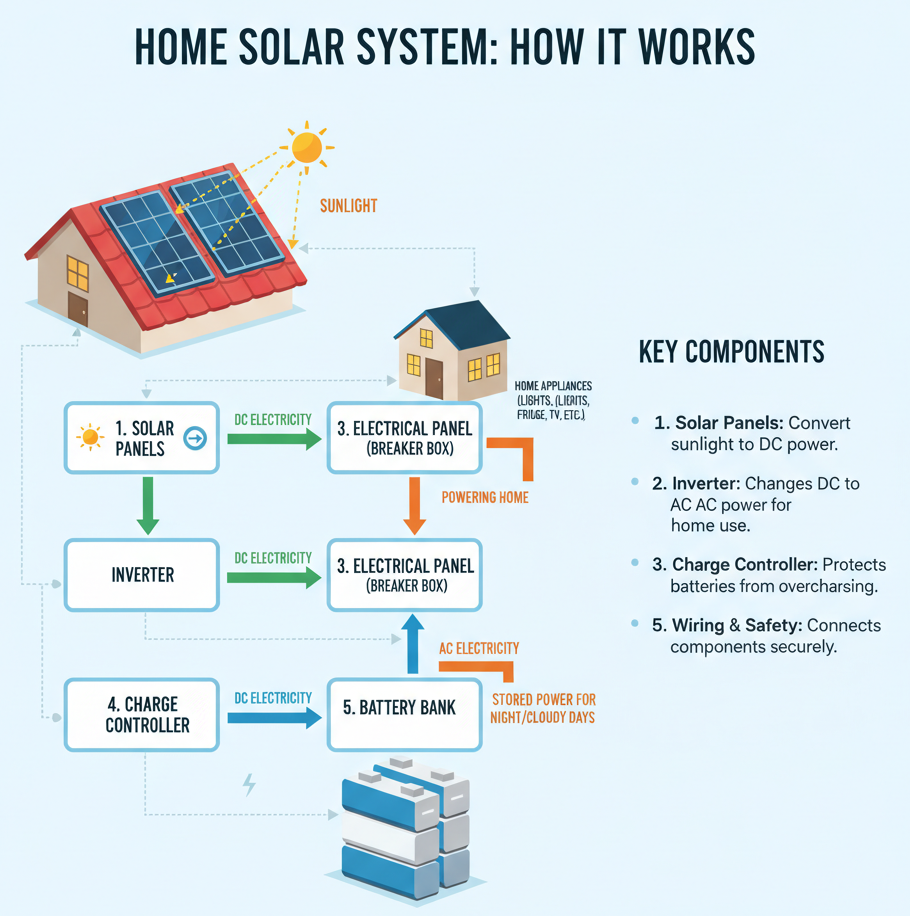Ever dreamt of a home powered entirely by the sun? Imagine saying goodbye to electricity bills and knowing your energy comes from a clean, limitless source. Sounds pretty good, right? Well, that dream is more achievable than you might think! Welcome to Solar Power 101, your very first step on the journey to understanding and potentially embracing a gridless future.
How Does the Magic Happen? The Basics of Solar Panels
At the heart of any solar power system are, of course, the solar panels themselves. But how do these sleek, dark rectangles actually turn sunlight into usable electricity? It all comes down to something called the photovoltaic effect.
Think of a solar panel as being made up of many individual solar cells. Each cell is typically made from layers of semiconductor material, most commonly silicon. When sunlight (which is made of tiny packets of energy called photons) hits these cells, it excites the electrons within the silicon. This excitement causes the electrons to move, creating an electric current. This current is Direct Current (DC) electricity – the same type of electricity that powers your car battery. Pretty neat, huh? It’s a silent, clean process happening right on your roof or in your yard!
Beyond the Panel: Components of a Simple Home Solar System
While solar panels are the stars of the show, they’re just one part of a complete home solar system. To go gridless, or even just to supplement your existing power, you’ll need a few other key components:
- Solar Panels: As we discussed, these convert sunlight into DC electricity. They are usually mounted on your roof or on ground-based racks.
- Inverter: This is a crucial piece of equipment. Since most home appliances run on Alternating Current (AC) electricity, the DC electricity produced by your panels needs to be converted. The inverter does exactly that, transforming DC into AC. There are different types of inverters, including string inverters and micro-inverters, each with their own advantages.
- Batteries (for Gridless Living): If your goal is true self-reliance and being completely off-grid, batteries are essential. They store the excess electricity your panels generate during the day so you can use it at night or on cloudy days. Without batteries, your power would only be available when the sun is shining.
- Charge Controller (with Batteries): If you have batteries, a charge controller is necessary to manage the power flowing from your solar panels to your batteries. It prevents overcharging, which can damage your batteries, and ensures they charge efficiently.
- Mounting System: This includes the racks and hardware that securely attach your solar panels to your roof or the ground, ensuring they are positioned for optimal sun exposure.
- Wiring and Electrical Safety Components: Like any electrical system, solar setups require appropriate wiring, circuit breakers, and other safety devices to ensure everything operates smoothly and safely.
Here’s a simplified visual of how these components work together:

The Sunny Side Up: Benefits of Solar Energy for Self-Reliance
Why are so many people looking to solar power? The benefits are compelling, especially if self-reliance is your goal:
- Energy Independence: This is perhaps the biggest draw for those looking to go “gridless.” With solar, you’re generating your own power, freeing yourself from reliance on utility companies and their fluctuating rates. No more worrying about blackouts during storms – you’re in control!
- Reduced or Eliminated Electricity Bills: For grid-tied systems, solar can significantly reduce your monthly electricity costs, often to zero. For off-grid systems, you eliminate them entirely! This can lead to substantial long-term savings.
- Environmental Friendliness: Solar energy is clean and renewable. It produces no greenhouse gas emissions during operation, helping to reduce your carbon footprint and combat climate change.
- Increased Home Value: Homes with solar panel installations often have a higher resale value, as buyers are increasingly recognizing the benefits of sustainable and energy-efficient living.
- Low Maintenance: Once installed, solar panel systems require minimal maintenance, usually just occasional cleaning to ensure optimal performance.
- Quiet Operation: Unlike generators or other power sources, solar panels operate silently, maintaining the peace and quiet of your home environment.
Your Journey Starts Now!
This is just the beginning! Understanding these basics is your first step towards harnessing the incredible power of the sun. Whether you dream of a fully gridless homestead or simply want to reduce your energy bill and environmental impact, solar power offers a powerful and rewarding path.
Ready to learn more? Stay tuned for our next post where we’ll dive deeper into sizing a system for your home and what to consider when planning your solar adventure!
